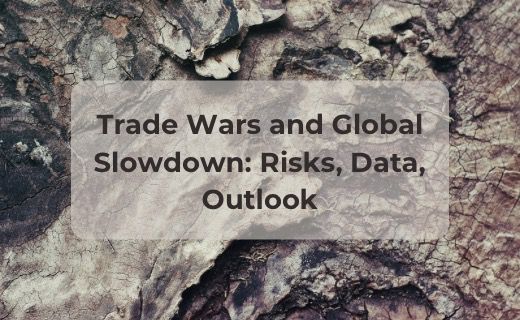Introduction: Analysing the Current Situation
In recent years, trade wars have re-emerged as a defining factor in global economic developments. The term describes situations in which countries impose tariffs, quotas, or other restrictions. Often, these actions come as retaliation for similar measures by other states.
Such conflicts are most visible between the United States and China. They also appear in tensions between the United States and the European Union. Additionally, protectionist policies are gaining traction in parts of Asia and Latin America.
Trade wars have a wide-ranging impact on the global economy. For example, rising tariffs increase the costs of importing raw materials and components. Higher expenses reduce business margins. Moreover, supply chain disruptions lead to delays, higher transport costs, and the urgent need to find new suppliers.
Investor confidence is also declining. Since governments can change trade policies without warning, long-term projects carry a higher risk. As a result, businesses hesitate to invest. Consumer demand also suffers, as higher prices reduce purchasing power and erode trust.
Together these effects feed into the global economic slowdown. Tariffs and instability exacerbate recessions, prolong recoveries, and hinder trade and investment flows.
Current Trends and Statistics in Trade Wars
Global Trade Growth Deceleration
According to the World Trade Organisation (WTO), the volume of world merchandise trade is expected to grow by 2.7% in 2024. This is slightly higher than the previous estimate of 2.6%. However, the 2025 forecast was revised down to 3.0% from 3.3%. The reason is persistent uncertainty and weaker demand, driven partly by trade wars (WTO, 2024).
Declining Global Economic Growth
The International Monetary Fund (IMF) projects global GDP growth to slow from 3.5% in 2022 to 3.0% in 2023. It is forecast to decline further to 2.9% in 2024 (IMF, 2023, via WEF). As a result, the world faces its weakest period of growth since the financial crisis and the pandemic.
Impact on the EU Economy
Models suggest that a full escalation of trade wars between the United States, China, and the European Union could reduce EU GDP by 2.5% in the short term. Long-term losses might reach 1.7%. The leading causes would be productivity declines and weaker investment.
Exposure of Export-Dependent Regions
Countries with large trade surpluses against the United States are more vulnerable. For example, in 2023, the EU’s surplus reached $205 billion. As a result, European companies face significant risks if Washington introduces new tariffs during trade wars.
Key Risks for Business in an Era of Trade Wars
Rising Costs
Tariffs and duties raise the price of imported goods and materials. This drives up production expenses and puts pressure on margins. Logistics costs also rise. Companies must adjust shipping routes, comply with new customs rules, and cover higher insurance charges.
Declining Demand
Higher tariffs lead to higher consumer prices. As a result, real income and purchasing power fall. In addition, consumer confidence drops. Many households delay big purchases due to uncertainty linked to trade wars.
Supply Chain Disruptions
Global manufacturers rely on complex international supply chains. When tariffs rise, they must find new suppliers or shift production to other regions. This takes time, money, and regulatory adjustments. It often results in lost competitiveness.
Strategic Uncertainty
Since governments frequently alter trade policies, long-term planning becomes challenging. For example, projects designed to last five or ten years may quickly lose value. In the era of trade wars, strategic uncertainty is now one of the most significant business risks.
Broader Consequences of Trade Wars
Slower Growth and Stagnation Risks
WTO and IMF data confirm that the global economy is slowing. Trade wars could entrench this trend, delaying recovery and lowering productivity growth.
Reconfigured Global Trade Flows
As a result of tariffs, companies are turning to regionalisation. For example, supply chains may shift to closer, politically stable partners. Intra-regional trade in Asia, Europe, and North America is expected to rise.
Rising Prices and Inflationary Pressure
Producers face two choices. They can absorb higher costs, which reduces margins, or pass them on to consumers. The latter fuels inflation, particularly in economies already struggling with cost-of-living challenges.
Greater Volatility and Financial Uncertainty
Trade disputes affect financial markets. Since investors factor in the risks of escalating trade wars, markets face higher volatility. Political uncertainty translates into increased risk premiums and weaker investment.
Long-Term Structural Shifts
Relocating production to less efficient regions lowers global productivity. Additionally, companies may delay adopting new technologies. This slows innovation. Finally, inequalities widen between countries and within societies. Winners and losers of trade wars emerge, and the gap between them grows.
Recommendations and Strategies for Businesses
Diversification of Markets and Suppliers
Firms should not depend on a single market or supplier. For example, expanding into new regions reduces reliance on one country. Exploring opportunities in emerging markets may also offer higher growth and fewer barriers.
Optimisation of Supply Chains
Localising production can reduce exposure to tariffs and logistics risks. Flexible supply chains make it easier to switch suppliers or routes. Businesses should also invest in quality control to ensure compliance with multiple international standards.
Risk Hedging
Financial tools can protect companies from uncertainty. Options, forwards, and currency swaps help manage volatility. Contracts should also include tariff adjustment clauses. Monitoring legislative changes enables firms to take action before new barriers emerge.
Embracing Digital Technologies
Digital systems enable the real-time monitoring of supply chains. Predictive analytics can model various trade war scenarios. Automation increases flexibility and reduces reliance on vulnerable imports.
The Role of Consulting Firms
Risk Analysis and Scenario Planning
Consulting firms can evaluate tariffs, sanctions, and trade barriers. They also design best-, worst-, and baseline-case scenarios. This helps companies plan effectively.
Crisis Management and Adaptation
Advisors assist in diversifying suppliers, adjusting logistics, and setting financial hedges. As a result, firms can respond quickly to changes in policies.
Identifying New Opportunities
Consultants can locate markets with favourable trade agreements. They also guide product adaptation and support entry into new markets.
Strategic Transformation
Consulting support includes advice on localisation and digital transformation. Firms gain tools for real-time monitoring and advanced planning. With expert guidance, businesses can turn the risks of trade wars into growth opportunities.
Future Outlook: Trade Wars and Global Prospects
Stagnation in 2025
WTO forecasts show weaker trade in 2025 than previously expected. If trade wars escalate, growth may even turn negative.
Persistently Low GDP Growth
Advanced economies may see slow growth due to debt and weak investment. Emerging markets such as India may perform better. However, they will not entirely escape the effects of trade wars.
Regionalisation of Supply Chains
Companies will rely more on regional trade blocs. Asia, Europe, and North America may strengthen ties. This shift reflects lessons learned from recent trade wars.
Return of Protectionism
Governments are more likely to use subsidies, tariffs, and support for domestic industries. This protectionism could lead to more disputes at the WTO and in bilateral deals.
Opportunities for Adaptive Businesses
Companies that diversify and use digital tools will benefit. They will be able to respond quickly and win market share. As a result, they can turn trade wars into an opportunity.
Our expert guidance in business forecasting will help you identify and mitigate threats and transform external challenges into strategic opportunities. [Contact Us]
Conclusion
Trade wars now shape the world economy. They reduce growth, weaken trade, and damage confidence.
WTO and IMF data confirm the fragile outlook. While moderate growth is possible in 2024, 2025 remains uncertain. For businesses, risks include higher costs, weaker demand, disrupted supply chains, and poor visibility for planning.
To remain resilient, firms must diversify, optimise, hedge, and digitalise. Consulting companies play a vital role in supporting these changes. They provide risk analysis, adaptation plans, and new growth strategies.
Ultimately, trade wars bring both risks and opportunities. Businesses that act quickly and strategically can transform turbulence into resilience and innovation.





